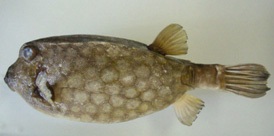Home » Tokyo Food Safety Information Center » Good things to know » Be careful with unfamiliar fish! Food poisoning from poisonous fish
Be careful with unfamiliar fish! Food poisoning from poisonous fish
Introduction
The first case of food poisoning caused by knobsnout parrotfish in Tokyo occurred in October 2011. In addition, Ostracion cubicus (boxfish), which may contain the same toxic component as knobsnout parrotfish, were sold at a fresh fish shop in Tokyo without removing the poisonous parts. Please be careful about unfamiliar fish.
Reported cases in Tokyo
Case 1: Food poisoning caused by knobsnout parrotfish
In October 2011, 4 employees at a restaurant in Tokyo ate curry containing the head and internal organs of knobsnout parrotfish as a staff meal, and all of them were hospitalized complaining of muscle pain and dyspnea 4 hours after the meal. This restaurant purchased the knobsnout parrotfish as “Japanese parrotfish” from Miyazaki Prefecture through a supplier in Tokyo, and the employees who cooked and ate it lacked awareness about knobsnout parrotfish as a poisonous fish.
- What is the toxic component of knobsnout parrotfish?
It is mainly distributed in the liver and sometimes in muscles. The toxic component is not eliminated by heating or washing with water. This toxic component is considered to be a “palytoxin-like toxin”, and a study is currently being implemented into in the details. - What are the symptoms?
Severe muscle (striated muscle) pain due to myolysis, blackish brown urine, dyspnea, and difficulty in walking, etc. Sometimes it results in death when the symptoms are serious. - What are the preventive measures against food poisoning?
There are no measures other than avoiding eating it.
The Ministry of Health, Labour and Welfare issued a circular on voluntary restraint of sales. - What are Okinawan “Irabucha”?
In Okinawa, knobsnout parrotfish and other similar fish are called as “Irabucha” and believed to be edible.However in fact, it is other types of Japanese parrotfish including chlorurus microrhinos and blue barred that are edible. Knobsnout parrotfish is not eaten even in Okinawa.
![[Characteristics of knobsnout parrotfish]
•Blue-green body
•Blue teeth, mouth like a bird’s beak
•Big head, with a bump in large fish
•About 80 cm long and weighs about 12 kg in mature fish
•Live in reef and coral areas from Tokyo to Okinawa](img/ao.png)
Case 2: Ostracion cubicus (boxfish) sold by mistake without removing poisonous parts
In October 2011, at a fresh fish shop in Tokyo, Ostracion cubicus (boxfish) were sold to ordinary consumers without removal of the liver and skin, which are the poisonous parts. The health center responsible for the area immediately instructed the shop to stop selling the fish, and raised public awareness.
Pufferfish should be sold after being cooked and processed including the removal of the poisonous parts by a “licensed pufferfish processing specialist” with specialized expertise in handling pufferfish. While there was a “licensed pufferfish processing specialist” at the said fresh fish shop, another employee decided independently to sell the fish without removing the poisonous parts.
-
Edible parts of Ostracion cubicus (boxfish)
Muscle and testis - Toxic component
While it is considered to be “palytoxin-like toxin”, the details are currently in investigation.


To prevent food poisoning caused by knobsnout parrotfish and Ostracion cubicus (boxfish)
- Avoid eating fish suspected to be knobsnout parrotfish.
- Eat Ostracion cubicus (boxfish) prepared by a “licensed pufferfish processing specialist.”
- When purchasing fish direct from production area, confirm the type of fish, and ask about toxicity and the edible parts of unfamiliar fish.
Other fish that containing the toxic component, “palytoxin”
Scrawled filefish has the toxic component “palytoxin” in its gastrointestinal tract and internal organs. While there have been no cases of food poisoning in humans, deaths have been reported in farm animals. Normally, they are believed to live in Sagami Bay and further south However, a scrawled filefish was caught in Hokkaido in October 2012. Eating it may be life threatening. Thus, as with knobsnout parrotfish, please avoid eating it.


Major toxic components in other seafood
| Causative substance | Major seafood causing food poisoning | Major symptoms | |
| Fish | Pufferfish toxin (tetrodotoxin) |
Pufferfish | Numbness in mouth and tongue, headache, vomiting, paralysis in limbs, speech difficulties, and death caused by dyspnea in some cases. |
| Ciguatera toxin | Fish (giant moray, great barracuda, yellow-edged lyretail, two-spot red snapper, rock porgy, etc.) living in tropical and sub-tropical marine areas, mainly around coral reefs. | It may take several months to recover from pain in mouth, lips and tongue, paralysis in limbs and mouth, nausea, vomiting, and abnormal temperature sensation (dry-ice sensation). | |
| Vitamin A | Japanese giant seabass (liver), etc. | Symptoms caused by excessive intake of vitamin A (severe headache, pyrexia, nausea, vomiting, and peeling of skin, etc.) | |
| Abnormal lipids (triglyceride, wax ester) |
Skilfish, escolar, oilfish | Diarrhea | |
| Bivalves | Paralytic shellfish poison | Shellfish that have ingested dinoflagellates that produce the substances that form shellfish poison. | Numbness in mouth, lips and limbs, ataxia, speech difficulties, etc. Some deaths have been reported. |
| Diarrheal shellfish poison | Diarrhea, nausea, vomiting, stomachache, etc. | ||
| Snails | Salivary gland toxin (tetramin) |
Buccinidae snails (neptunea arthritica, neptunea intersculpta, etc.) | Dizziness, nausea, vomiting, feeling of drunkenness, numbness in limbs, etc. |
| Pufferfish toxin (tetrodotoxin) |
Carnivorous snails such as goldencup (Hypericum patulum), etc. | Numbness in mouth and tongue, headache, vomiting, paralysis in limbs, speech difficulties, etc. There are some deaths caused by dyspnea. |